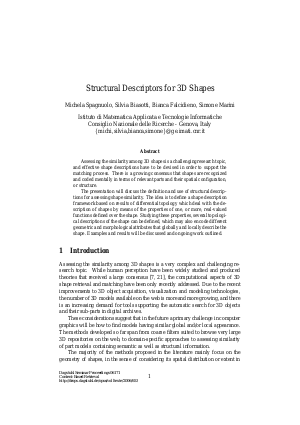Structural Descriptors for 3D Shapes
Authors Michela Spagnuolo, Silvia Biasotti, Bianca Falcidieno, Simone Marini
-
Part of:
Volume:
Dagstuhl Seminar Proceedings, Volume 6171
Part of: Series: Dagstuhl Seminar Proceedings (DagSemProc) - License:
 Creative Commons Attribution 4.0 International license
Creative Commons Attribution 4.0 International license
- Publication Date: 2006-09-19
File

PDF
DagSemProc.06171.10.pdf
- Filesize: 108 kB
- 11 pages
Document Identifiers
Subject Classification
Keywords
- 3D shape descriptors
- computational topology
Metrics
- Access Statistics
-
Total Accesses (updated on a weekly basis)
0Document
0Metadata
Abstract
Assessing the similarity among 3D shapes is a very complex and challenging research topic. While human perception have been widely studied and produced theories that received a large consensus, the computational aspects of 3D shape retrieval and matching have been only recently addressed.
The majority of the methods proposed in the literature mainly focus on the geometry of shapes, in the sense of considering its spatial distribution or extent in the 3D space. From a practical point of view, the main advantage of these methods is that they do not make specific assumption on the topology of the digital models, usually triangle meshes or even triangle soups. Moreover, these methods are also computationally efficient.
There is a growing consensus, however, that shapes are recognized and coded mentally in terms of relevant parts and their spatial configuration, or structure. Methods approaching the problem from a geometric point of view do not take into account the structure of the shape and generally the similarity distance between two objects depends
on their spatial embedding.
The presentation will discuss the definition and use of structural descriptions for assessing shape similarity. The idea is to define a shape description framework based on results of differential topology which deal with the description of shapes by means of the properties of one, or more, real-valued functions defined over the shape. Studying these properties, several topological descriptions of the shape can be defined, which may also encode different geometric and morphological attributes that globally and locally describe the shape. Examples and results will be discussed and ongoing work outlined.
This work is partially supported by the EU Newtwork of Excellence AIM{@}SHAPE.
Cite As Get BibTex
Michela Spagnuolo, Silvia Biasotti, Bianca Falcidieno, and Simone Marini. Structural Descriptors for 3D Shapes. In Content-Based Retrieval. Dagstuhl Seminar Proceedings, Volume 6171, pp. 1-11, Schloss Dagstuhl – Leibniz-Zentrum für Informatik (2006)
https://doi.org/10.4230/DagSemProc.06171.10
BibTex
@InProceedings{spagnuolo_et_al:DagSemProc.06171.10,
author = {Spagnuolo, Michela and Biasotti, Silvia and Falcidieno, Bianca and Marini, Simone},
title = {{Structural Descriptors for 3D Shapes}},
booktitle = {Content-Based Retrieval},
pages = {1--11},
series = {Dagstuhl Seminar Proceedings (DagSemProc)},
ISSN = {1862-4405},
year = {2006},
volume = {6171},
editor = {Tim Crawford and Remco C. Veltkamp},
publisher = {Schloss Dagstuhl -- Leibniz-Zentrum f{\"u}r Informatik},
address = {Dagstuhl, Germany},
URL = {https://drops.dagstuhl.de/entities/document/10.4230/DagSemProc.06171.10},
URN = {urn:nbn:de:0030-drops-6532},
doi = {10.4230/DagSemProc.06171.10},
annote = {Keywords: 3D shape descriptors, computational topology}
}
